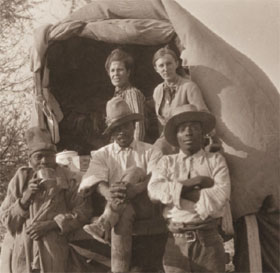Dusting off Bleek's field notebooks

'This project is driven by desire to put Dorothea Bleek's work on the table for debate and to give similar recognition to the record of her life to that which has been afforded her father and aunt,' says Weintroub.
The surviving written record of Bleek's trip to Kakia (now Khakhea) in the then Bechuanaland Protectorate (now Botswana) includes a day-by-day diary which Bleek kept alongside two additional notebooks. Along with the limited private correspondence preserved in the archive, this diary presents a glimpse of rare personal narrative in an archive comprising a greater proportion of general material. Weintroub's book offers a close reading of one of Bleek's earliest forays into the field in southern Africa.
'The diary of Bleek's trip to Kakia, together with the two research notebooks produced there, provide a more complete record of Bleek's emerging fieldwork practice and method than what remains available in relation to any of her later trips,' says the author. 'The daily record of her journey and two-week sojourn when she and her friend Margarethe Vollmer (and their support staff and wagon crew) camped under a tree at Kakia, gives an intimate view of daily living and developing research practice as these evolved over time.
'It shows Dorothea engaging with the landscape and the people she found therein in a myriad of complex and contradictory ways. One can see her on one hand as the genteel colonial traveller "on safari" through conquered territories surveying, framing and domesticating surrounding landscapes using language and metaphor drawn from the painterly tradition of Western art,' says Weintroub. 'On the other hand, she is the intrepid female explorer celebrating her escape from domesticity and suburbia, indulging in solitary walks and in conventionally male escapades (like pistol shooting) which in contemporary culture one could expect to see in an "Indiana Jones"-type adventure movie.
'She is also the Western scientist investigating African bodies with her measuring instruments and camera, deploying colonial authority to gain access to intimate spaces of other bodies, but at certain times exhibited sensitivity to the invasion of personal space thus signified, and to the limits of power she could exert.
'One moment, we see her as the expert who brings the comfort of Western medicine to the suffering native. At another moment, she appears fully engaged in the ritual practices she is observing, and finds her research subjects both attractive and amusing.
'What makes this glimpse into Dorothea Bleek's fieldwork so intriguing and interesting is the fact that it is so brief and fleeting. The unguarded, intimate moments revealed in Bleek's Kakia journal are not repeated again in the documentary record of her life and scholarship. This detailed reading of this particular field trip offers a unique moment in which the texture of Bleek's early field encounters, and the processes of her early field research can be teased out.'
Weintroub's immaculately crafted volume is part of the LLAREC (Lucy Lloyd Archive, Resource and Exhibition Centre) Series in Visual History, which is being produced by the Centre for Curating the Archive at the University of Cape Town.
Jill Weintroub is an honorary research scholar with the Archive and Public Culture Research Initiative